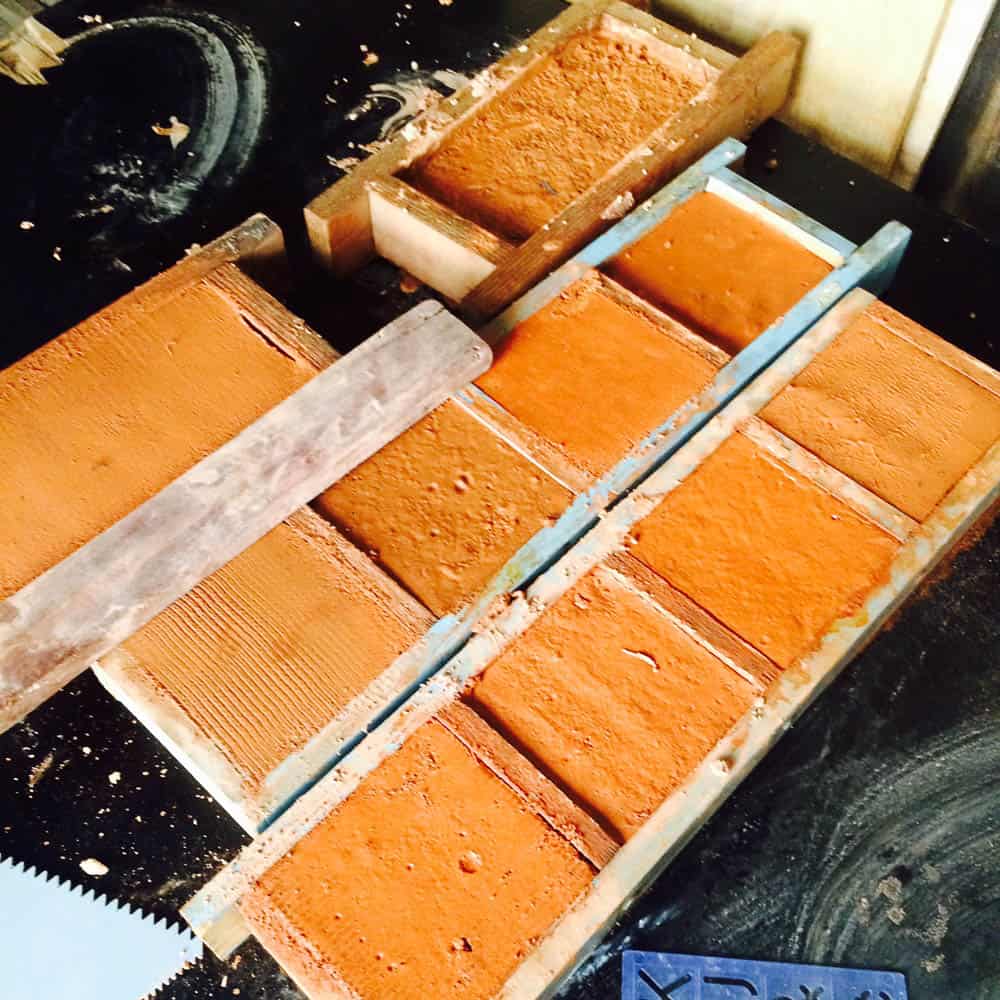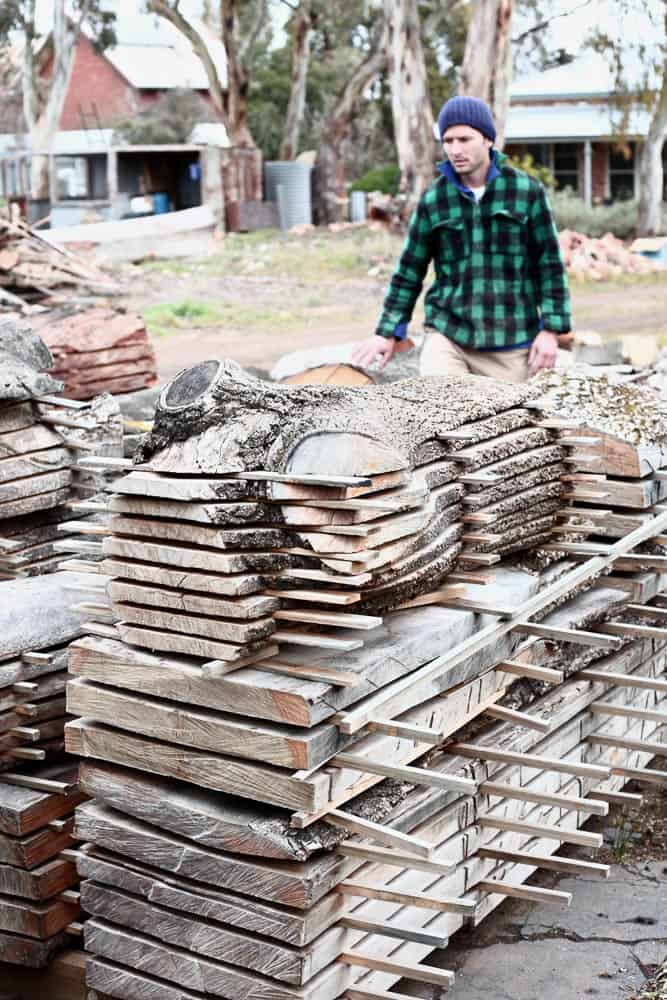- Emily and Rick at First Coat Festival. photo: Benjamin Tupas of ABC Open
- Peter Bosworth, custom drum kit. Image courtesy of the artist
- Woodworker Aaron Barton in his studio. Image courtesy of the artist
- Blacksmith David Bradley in his workshop, photo: Richard Stride
- Clare Elizabeth Kennedy’s Five Mile Radius workshop in the Foundry Studios. Red Hill, QLD, photo: Clare Elizabeth Kennedy
- Drum maker, Peter Bosworth in his studio. Image courtesy of artisan.
- Little Peach Co, David Atkinson with Heidelberg Platen Press, courtesy of the artist
- Clare Kennedy, Fired brick
- Eleisha Nylund at work, photo: We Are The Tsudons
- Emily Devers at work, courtesy of the artists
- Lachlan Park sourcing wood for his furniture and tools, courtesy of the artist
- Leila during the bladesmithing process. Image courtesy of the artist
The Apprenticeship is an exhibition at Artisan in Brisbane (19 April – 25 June 2016) which profiles individuals who’ve created their own pathways to learn craft skills for their trade or profession. We hear from the curators about reasons for this exhibition and explore the example of artisanal brick-making.
How did the idea come about?
My co-curator for the exhibition, Aaron Barton, originally approached us with an idea to have an exhibition called The Apprenticeship. This marked the end of the three-year a self-guided apprenticeship in furniture making. He opted not to take the formal route, because he felt it wouldn’t provide him with the traditional joinery skills he wanted and would also be poorly paid. I thought it was an interesting proposal, but I wondered if there was a bigger story to tell about apprenticeships and craftspeople finding their own pathways to revive crafts and trades today. So we did some research and found there was a larger trend of people having to pioneer new pathways because the traditional apprenticeship model for their particular craft had either disappeared, lost its connection to the traditional hand skills, become financially unviable or even did not align with their particular ethical or philosophical stance. We aimed to explore this tendency by showcasing the work and stories of a selection of makers from varied crafts or trades, each having followed a different pathway to establish their practice. The idea is to provide a platform for discussion around what an apprenticeship might look like today, which provides makers with the skills they need to develop successful craft businesses within today’s economy, or what alternative models there might be.
Would you say there was a revival of these specialist skills? If so, where does that come from?
In developing The Apprenticeship, it became apparent that craftspeople have not only had to revive or rediscover the skills of their craft, but also had to adapt the products and business model to operate within today’s economy dominated by mass production. Prior to the Industrial Revolution, the handmade was the only option available to consumers, and craftspeople did not have to find ways to add value to their products in order to compete with the almost inevitably cheaper and faster mass-produced items. While the shift to mass production has certainly had its benefits, I think today people are increasingly aware of what has also been lost in this shift, and that is the story of the production of objects—their materials, origins, makers and processes of production. So I think we have arrived at a point where the inherent, or at least current, limitations of mass production have led to the regrowth of a market for the handmade. This enables people to have a much better engagement with and understanding of the production of their objects, and thereby enjoy benefits such as sustainable and custom design and the experience of character rich objects. The idea of the experience economy provides an interesting lens through which to consider the revival of hand-making, as I think that, aside from ethical and environmental concerns, what a lot of people are after is an experience embedded into the objects they buy, be it through the story of the maker, the material, the design or even the act of exchange itself. Makers are becoming increasingly savvy in providing this experience for their buyers through social media and things like workshops and markets that enable direct engagement with consumers in a way that large mass producers struggle to achieve.
What do you think is the relationship between craft “trades” like brick-making and studio crafts that produce works of art?
In developing an exhibition titled The Apprenticeship it was always going to be necessary to discuss trades. In particular, the relationship between trades and the crafts, which are more typically the focus of artisan, quickly came into question. There are a number of ways to look at the relationship and differences between them, but I think the difference between root meanings of the words ‘trade’ and ‘craft’ is most interesting in relation to this exhibition. Rather than trying to distinguish between crafts and trades in terms of medium or function, it could be considered more about approach, with trade (an act of commercial exchange and benefit) being the primary driver of trades, and craft (the skill and process of hand production) being the primary driver of craft practices. What we’re seeing with many of the artists in The Apprenticeship is that they are not satisfied with the trades approach to their medium, which may have moved away from the hand production through the pressures of the Industrial Revolution. Instead, they are returning to a crafts approach, which enables them to control their practice and products and create greater meaning and value in them. This is certainly evident for the brick-maker and signwriters in the exhibition, for example, who have gone back to the original hand making process, which is completely different to the prevalent mass production methods. They are finding that, by focusing on what is unique about the means of hand production and taking a craft approach, they are able to find a market for their small-scale practices in fields generally considered trades.
There are countries in our region where many of the traditional skills have survived. Do you think it’s useful to look at and learn from those cultures> Are there any issues with that?
I think there are certainly countries where, for one reason or another, certain crafts have survived better than in Australia. Mass production requires substantial initial investment and the capacity to manufacture the tools of mass production themselves. In developing countries with strong existing craft practices, this would often create a barrier to shifting to the industrial mode of production. As such, I think that it might be useful to look to these cultures to learn hand production skills if they have been lost locally. In terms of pathways specifically, I also think that a lot could be learnt from how these cultures, particularly indigenous communities, both in Australia and beyond, transfer craft skills. But in terms of what objects and business models are going to work, it may not be as helpful because the marketplaces would be quite different across cultures. When handmade products are the only available option within the marketplace, makers do not have to distinguish their product from the mass produced by communicating the story of its production, which is something that is so crucial to all the makers featured in The Apprenticeship.
That said, I imagine there is probably a growing number of interesting examples within different cultures of new affordable technologies being utilised by craft practices to complement or replace certain aspects of traditional hand production that could be of benefit to local makers. This is explored in The Apprenticeship in the work of leatherworker Eleisha Nylund for example, who uses a small laser cutter and etcher to create patterns for her pieces, which are then hand stitched, dyed and finished traditionally.
Case study – Clare Elizabeth Kennedy
One of the artists featured in The Apprenticeship is architectural designer Clare Elizabeth Kennedy. Clare has an interest in the origins of building materials with a particular focus on earth construction and brick making. The interview below is a short prelude to a far more detailed article on the fading practices of artisanal brick making that will feature in our December issue based on India. India is one of the few countries to still be practicing the traditional forms and methods of brick making and firing.
For something that may not be around too long or may even find its way back into the building of our modern world of industrialization, the humble brick has a fascinating story and an intriguing future. Will we even need bricks at all? And if so, what kind? Read on to know more about what may become of basic yet very essential ‘building block…’
What is it about bricks that interest you? From the expanse of architectural design, you chose the microcosm of the brick… why?
I am interested in the origins of construction materials. My work centers on the idea that the raw materials for construction should come from close to the building site and ideally be built by the local people. This ‘closed loop’ method of production is how we operated historically and it is gaining renewed popularity—particularly in the fashion and food industries. More people are choosing to live in self-sufficient communities sharing skills and resources. I was frustrated in my architectural practice because we simply source and specify synthetic building materials off the Internet. Everything is shipped to the site, and buildings are all starting to look the same. I can’t understand it and so I’m choosing to explore the polar opposite.
The diversity of dirt is fascinating to me. Fired brick, mud brick, plasters, paints, mud floors, tiles—they all come from one humble, easy to use resource available to almost all people. Vitrifying clay—that is firing dirt to create waterproof bricks and tiles gives this basic, attainable material the capacity to create robust shelter. A brick becomes a record of a place and its people. The dirt that is used, the additives and finishes, the mould and its makers, the firing process and the final use all combine to tell a story unique to the location.
When you work on projects, do you build traditional kilns on site, like those in India and Africa or do you take the clay back to a factory to have the brick made?
At the moment, while in Australia, I’ve been using kilns at a local factory here in Brisbane. I source the clay and form the bricks by hand in my workshop (see fivemileradius.org) and then transport them to the factory to be fired. My ambition is to work with universities creating mobile workshops and installing traditional kilns in a variety of Australian landscapes creating site-specific structures that address the needs of the local community, using a variety of earth construction techniques. Rainforest build, desert build, coastal build—that sort of thing. Sand, lime, ochres, clays, rocks, We’ll use what’s available and what’s necessary to create shelter.
How do you deal with the challenges of the irregularities in the handmade?
I work with the irregularities. I design outwards from the material‘s initial condition. Where possible I will always try to let the material best express itself. What did Louis Kahn say? “Honour the brick and glorify the brick instead of short-changing it.” Clay is capricious. It shrinks, warps, cracks and twists, but sometimes this presents opportunity rather than constraint. Perfect imperfection. To me an irregularity used well will always be rewarding and beautiful.
What are your plans for India later this year and what do you propose to study or understand in terms of the contemporary practices of artisanal brick making
Very exciting. I’m assisting on a two-week workshop in Bangalore set up by the wonderful Architectural Association of London. We’re spending the time with a group of international students exploring local brick production and working with small and large scale factories to design and build small structures around the city. I can’t wait to see what emerges.
After the workshop finishes, I’m heading south into Kerala to again study the work of the late architect Laurie Baker whose site based ethos and extraordinary brickwork have truly inspired me.
I’m also going to keep working on a story I began last year centered on the changing brick industry in India. The industry is in decline due to soil shortages, and in Kerala, for instance, beautiful unused brick factories are littered around the lush landscape. It’s a story worth telling.
Author
 Richard Stride is the Exhibitions Manager and Acting Curator at artisan in Brisbane. He completed an honours degree in Visual Art at Queensland University of Technology and has an interest in collaboration, the maker movement, DIY culture and the form and function of everyday objects. Richard is also a practicing artist working primarily across installation, sculpture and drawing. His practice he explores tensions within the built environment and the intersections of visual art with design and architecture, particularly in relation to the legacies of modernism. Richard has previously worked at the Tate Modern and Tate Britain in London and Artslink Queensland, and is co-director of artist-run initiative Current Projects, for which he has curated Dispatch, a two-year exchange project between 11 window galleries across Australia.
Richard Stride is the Exhibitions Manager and Acting Curator at artisan in Brisbane. He completed an honours degree in Visual Art at Queensland University of Technology and has an interest in collaboration, the maker movement, DIY culture and the form and function of everyday objects. Richard is also a practicing artist working primarily across installation, sculpture and drawing. His practice he explores tensions within the built environment and the intersections of visual art with design and architecture, particularly in relation to the legacies of modernism. Richard has previously worked at the Tate Modern and Tate Britain in London and Artslink Queensland, and is co-director of artist-run initiative Current Projects, for which he has curated Dispatch, a two-year exchange project between 11 window galleries across Australia.













